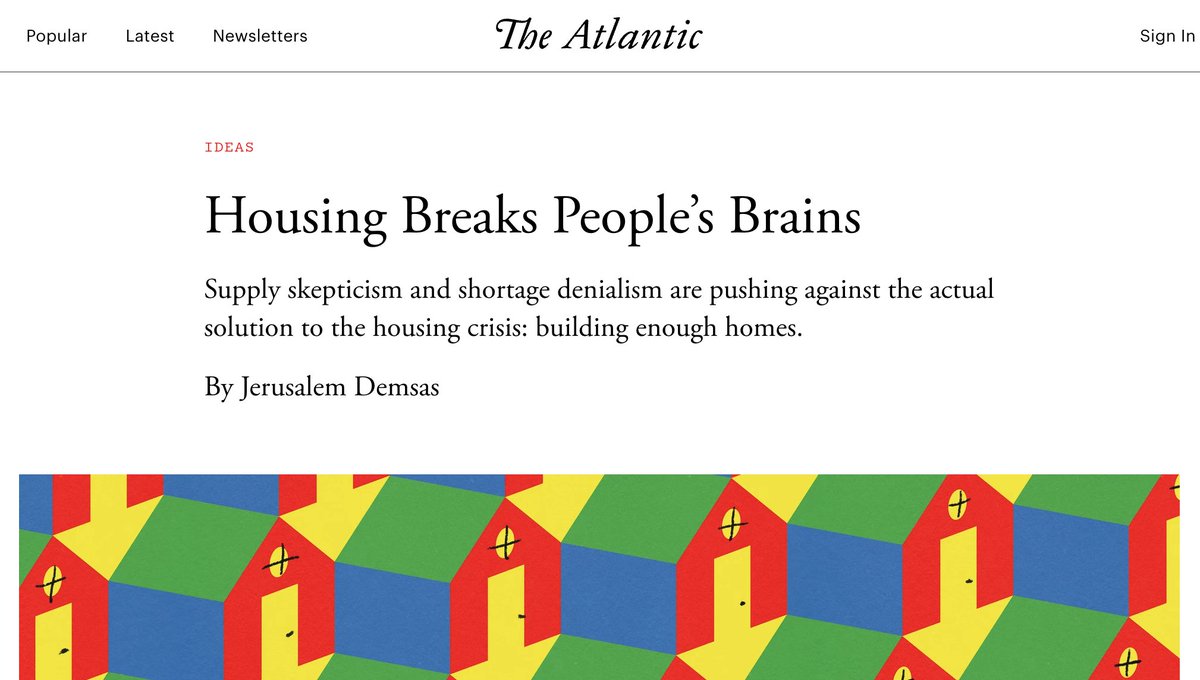
Chris Elmendorf@CSElmendorf
Apr 30, 2024
21 tweets
 New papers! A cornucopia! (well, 3).
New papers! A cornucopia! (well, 3). #1: "What State Housing Policies Do Voters Want? Evidence from a Platform-Choice Experiment" (w/@Clayton Nall & @Stan Oklobdzija)
written for a @JPIPE symposium on political economy of housing
papers.ssrn.com/sol3/papers.cf
#1: "What State Housing Policies Do Voters Want? Evidence from a Platform-Choice Experiment" (w/@Clayton Nall & @Stan Oklobdzija)
written for a @JPIPE symposium on political economy of housing
papers.ssrn.com/sol3/papers.cf
 /21
/21
 New papers! A cornucopia! (well, 3).
New papers! A cornucopia! (well, 3). #1: "What State Housing Policies Do Voters Want? Evidence from a Platform-Choice Experiment" (w/@Clayton Nall & @Stan Oklobdzija)
written for a @JPIPE symposium on political economy of housing
papers.ssrn.com/sol3/papers.cf
#1: "What State Housing Policies Do Voters Want? Evidence from a Platform-Choice Experiment" (w/@Clayton Nall & @Stan Oklobdzija)
written for a @JPIPE symposium on political economy of housing
papers.ssrn.com/sol3/papers.cf
 /21
/21 #2: the long-awaited revision of "Folk Economics and the Persistence of Political Opposition to New Housing" (w/@Clayton Nall & @Stan Oklobdzija)
a/k/a, our "Housing Breaks Brains" paper
now greatly improved, thanks to @Aletheia peer-review process
papers.ssrn.com/sol3/papers.cf
/2
#3: "Plain-Bagel Streamlining? Notes from the California Housing Wars" (w/ @Clayton Nall)
forthcoming in a @Case Western Reserve Law Review symposium on "Permitting the Future," organized by @Jonathan H. Adler
/3
papers.ssrn.com/sol3/papers.cf
What are the takeaways?
The main finding from our original "Folk Economics" paper is (1) that nearly all renters and even a majority of homeowners say they want lower housing prices, but (2) they don't think that even a large regional supply shock would reduce prices.
/4
In the "Folk Economics" revision, we show w/new data that beliefs about effect of housing supply shocks on prices are unstable (across & within surveys), in contrast to beliefs supply shocks in other markets ... and beliefs about who's to blame for high housing prices.
/5
(Who's to blame for unaffordable housing? Why developers and landlords, of course!)
/6
So if people want lower housing prices but don't think more supply will help, what *do* they think state govts should be doing instead?
That's the question we set out to answer in the @JPIPE paper.
/7
We elicited beliefs about the efficacy of--and preference with respect to--17 different housing policies, running the gamut from supply liberalization, to price controls, to restrictions on "Wall St" investors, to IZ, and more.
/8
Before eliciting beliefs, we also provided a primer on zoning, and we defined key terms like "market-rate housing" and "subsidized affordable housing."
/9
Finally, we had respondents choose between randomly composed 3-policy "platforms," which mixed housing and prominent non-housing policies.
This allows us to estimate the relative importance of housing and non-housing policies in elections for state gov't.
/10
What do we find?
The people want price controls! And demand subsidies! And restrictions on Wall. St. investors!
/11
Upzoning for "subsidized affordable housing" is vastly more popular (25 percentage points) than upzoning for "market-rate housing."
/12
And, in another strike against the "homevoter hypothesis," renters in our sample were actually *less* supportive of upzoning for market-rate housing than the homeowners!
/13
But do any of these policies matter when push comes to shove, and voters have to make tradeoffs with policies like abortion, health care, minimum wage, climate?
Yes. Rent control is near the top, w/ property-tax controls, IZ, and "Wall St" restrictions not far behind.
/14
Also, people who want rent control and Wall. St. restrictions care a lot more about these policies than do their opponents, whereas opponents of market-rate infill development care somewhat more about it than do the proponents.
/15
A couple of "YIMBY" policies do enjoy broad support, though they aren't priorities for most people: limitations on development fees & taxes, and limitations on local permitting discretion.
/16
On balance, we conclude that housing-policy salience is bad news for YIMBYs.
State-level versions of what @Matthew Yglesias calls "The Secret Congress" hold much more promise.
/17
slowboring.com/p/the-rise-and
That takes us to the third paper, "Plain Bagel Streamlining?"
It both documents the (often Secret Congressish) achievements of California's housing policymakers, and introduces some new data on California public opinion, courtesy of a survey we conduced w/ @Institute of Governmental Studies.
/18
Similar to nat'l data in the platform-choice paper, our IGS survey suggests that the median California voter is on the fence about upzoning for apartments near transit, for 2-4 unit buildings in SFH areas, & even about proposed "local control" ballot measure.
/19
We hope this paper will be a useful resource for policymakers in other states, and also for researchers who (like us) are trying to understand the conditions under which more effective modalities of "abundance" policymaking can take hold.
/20
As for California, it has a long ways still to go...
/end

Chris Elmendorf
@CSElmendorf
The law prof at UC Davis, not the developer in San Diego. Dad. Denizen of San Francisco. Patron of Amtrak. Tweets are my own, not statements of UC. (he/him)
Missing some tweets in this thread? Or failed to load images or videos? You can try to .

















